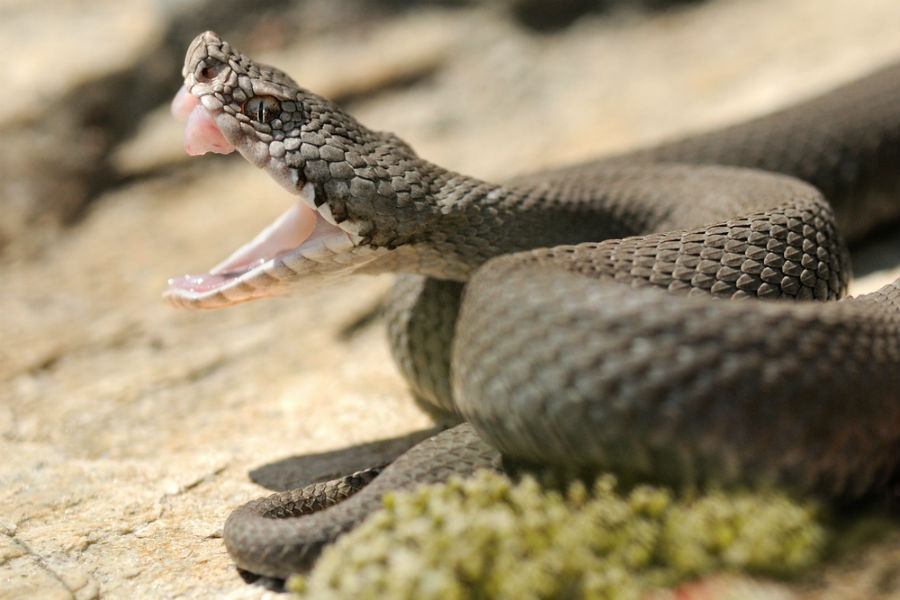Bitten by a Snake
Animal & Bug Bites
•
Jun 6, 2018

It’s a hiker’s worst nightmare – you’re four miles into a 10-mile loop when you startle an unsuspecting snake. The snake does what it’s programmed to do and lashes out to defend itself against a perceived threat – in this case, you.
What Should You Do If a Snake Bites You?
What do you do? Equally important, what should you not do? There is, unfortunately, a lot of misinformation propagated by popular culture that could easily cause much more harm than good.
1. Do NOT attempt to suck out the venom.
Popular media often shows people or their friends attempting to suck the venom out. Although comedy ensues on the screen, this should be avoided in real life. The same goes for cutting the area to try to bleed the venom out or otherwise remove it. This only increases the chance of infection and excessive bleeding. Chances are, your knife isn’t sterile anyways.
Using a suction device or trying to suck the venom out with your mouth is not an effective treatment. Studies have shown this only removes a negligible amount of venom, at most. If anything, it only increases the chance of infection.
2. Do NOT tourniquet the area.
You should actually take off any restrictive clothing, such as a watch if you’re bitten on the hand or arm, to allow blood flow. The venom will spread regardless and the area will swell. Having restrictive clothing on could cause injury and having the venom concentrated in one spot could exacerbate tissue damage.
3. Clean the wound.
You should clean and disinfect the wound, although there’s not a whole lot else you can do without anti-venom at this point.
4. Restrict affected limb movement.
Movement of the limb should be restricted as much as possible, but you should also try to get out of the area to reach first aid. If the bite is on your arm or hand, consider creating a sling to minimize movement of the affected limb.
5. Call 911.
If you are bitten out on the trail and you don’t have cell reception, you need to get to an area where you can call 911. If you’re with people, which you should be if you’re on a long hike or backpacking, you could let someone else hike to get help. However, if this will delay you in reaching a hospital or clinic that possesses anti-venom, it may be better for you to hike out yourself if you’re able.
6. Stay calm.
Staying calm is important, as you should preferably keep your heart rate low to slow the venom’s spread. One of the most common ways snake bites lead to serious injuries is the initial flight reaction of the victim. More people suffer severe injuries tripping over rocks or roots while trying to flee or falling down steep inclines off the sides of trails than from the bite itself.
7. Do NOT ice the area.
Although ice may numb the pain, it also reduces blood flow, which should be avoided.
8. Avoid driving if possible.
Driving yourself to an urgent care clinic or emergency room isn’t always ideal because the venom may affect your ability to operate a motor vehicle.
If you’re deep in the wilderness with no cell reception, waiting also shouldn’t be considered a viable option. Unless you’re confident someone with a satellite phone is going to happen upon you in short order, you need to try to get out and reach first aid.
9. Find the nearest hospital with antivenom
Bites are serious, and you should seek the assistance of a medical professional who can administer anti-venom as soon as possible, but panic will not improve your situation.
According to the Centers for Disease Control and Prevention, approximately 7,000 to 8,000 people are bitten by snakes in the United States every year. Only about five of those people die, and it’s often due to an allergic reaction to the snake venom. Anti-venom is highly effective, and many venomous snakes are not quite as deadly as media would have you believe.
How to Avoid Being Bitten by a Snake
One of the best things you can do is simply avoid being bitten by a snake. There are certain precautions hikers can take to minimize their chance of being bitten.
Watch where you’re stepping. Snakes like to sunbathe on warm rocks, so watch out for rocky, sunny spots. They also like to hide in piles of leaves or other camouflaged places while they wait for prey. Some people will advise you to step on a rock or log instead of over it because a snake could be hiding underneath and may lunge at the back of your foot or ankle if startled. This goes for any dark holes or crevices – they’re generally best avoided.
Don’t try to chase or move a snake if you see one on the trail. Just avoid it and warn other hikers that there is a snake on the trail.
If you’re listening to music, podcasts, or audiobooks, only keep one earbud in. Hearing is an important sense, especially when it comes to rattlesnakes that have a built-in warning to help you avoid them.
Be more alert during morning hikes. Snakes generally like to rest during the day and are most active at night, so hikers tend to run into them more often in the early morning or evening.
Get Help From a Complete Care ER or Urgent Care
If you are bitten by a snake in Texas or Colorado Springs, Colorado, there may be a Complete Care urgent care or ER nearby to provide assistance. Our highly skilled medical professionals can quickly provide the treatment you need to recover from snake bites so you don’t experience any lasting damage and can get back out on the trail as soon as possible. Visit us online to find a Complete Care facility nearest you.
Sources
http://extramilest.com/blog/what-to-do-when-a-snake-bites-you-on-a-remote-trail/
https://healthcare.utah.edu/the-scope/shows.php?shows=0_vookb28x
https://americanhiking.org/blog/prevent-snake-bites/
https://www.cdc.gov/niosh/topics/snakes/recommendations.html